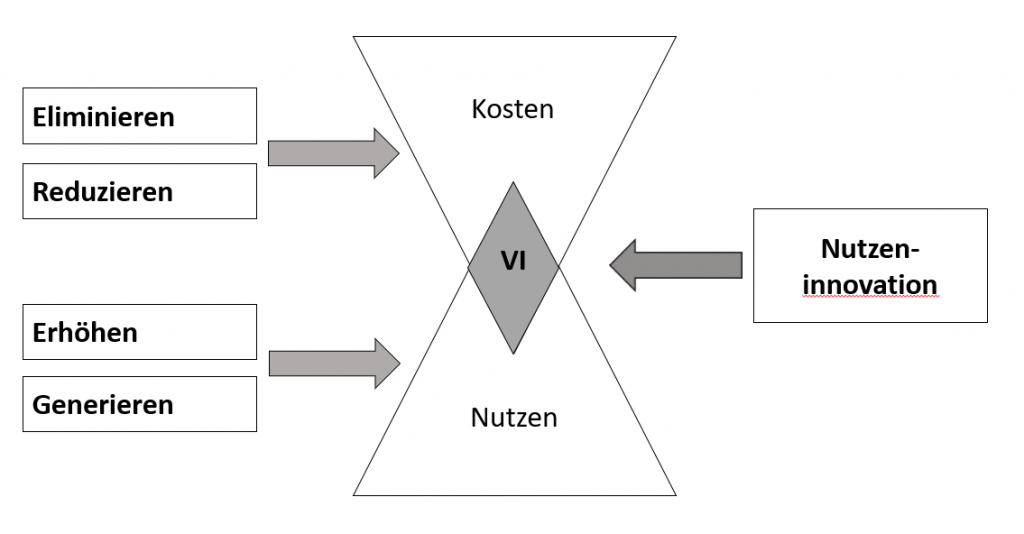A popular concept for creating new business models is the Blue Ocean Strategy [1], which was developed by W. Chan Kim and Renée Mauborgne based on empirical studies. In this context, the term “ocean” stands for a market or industry:
Blue Oceans are uncontested new markets with little or no competition.
“Red Oceans”, on the other hand, are saturated markets where everyone offers the same products and which are therefore characterized by fierce competition.
This strategy is based on the idea that successful companies should not orientate themselves to the competition, but should seek their own ways. This requires innovations that either open up new markets or increase demand in existing markets, since the existing competitors do not (yet) offer the new features. Successful innovations are usually not based on technological innovations, but rather on a novel design of the overall offering. The focus of this approach is ,therefore, on redefining the market or the consumers.
“Gehe dahin, wo Gewinne und Wachstum sind – und nicht der Wettbewerb.”
Go where profits and growth are – and not the competition
(W. Chan Kim / Renée Mauborgne)
“ The only way to beat the competition is to stop trying to beat the competition.” (W. Chan Kim / Renée Mauborgne, P.4)
The two ocean strategies are characterized by the following features:
Red-Ocean-Strategy | Blue-Ocean-Strategy |
| Competition in the existing market | Creation of new markets |
| Beating the competition | Avoiding the competition |
| Using the existing demand | Developing new demand |
| The direct link between profits and costs | Eliminating the direct link between benefits an costs |
| Alignment of the overall system of corporate activities with the strategic decision for differentiation or low costs | Orientation of the overall system of corporate activity towards differentiation and low costs |
Value Innovation
The cornerstone of blue ocean strategy is the so-called value innovation. The simultaneous striving for differentiation and low costs is meant with it. The value innovation concentrates on creating a precipitous rise of the product use both for the buyers and for the enterprise, in order to open thereby new and uncontested markets and thus make the competition meaningless.
Advantageous part for the buyers are the offer with improved benefit and low price. In contrast, the advantage for the company is the difference between the offer price and the costs. Value innovation can, therefore, only be achieved if the entire system is geared towards strengthening customer benefit on the one hand and reducing the company’s costs on the other (see Fig. 1.9).

Strategy Canvas
The strategy canvas (so-called Strategie-Leinwand) is the central diagnostic framework, from which the necessary elements for a successful blue ocean strategy are derived. This is a diagram on whose horizontal axis the factors are displayed with which the industry competes and in which it invests. The vertical axis shows the degree of benefit to the customer.
This instrument helps to get an overview of the current status and the market influencing factors of the respective industry. Both the top supplier and smaller suppliers in a market are considered. Depending on the industry, product characteristics, but also other aspects such as service, ambience or pricing can be important. The result is a value curve that shows what the respective competitors place value on.

Four Actions Framework
In the next step, the most important features from the customer’s point of view are developed with the help of the four actions framework. This involves a cost-benefit analysis with the following questions in order to create a new benefit curve:
- “Which of the factors that the industry takes for granted should be eliminated?”
- “Which factors should be reduced well below the industry’s standard?”
- “Which factors should be raised well above the industry’s standard?”
- “Which factors should be created that the industry has never offered?”
The first two questions help to reduce costs. With the resources freed up, the company can modify the factors to which the last two questions refer, improving key features and allowing new features to create new customer value.

ERRC-Grid
The benefit curve for the company can be created using the Eliminate-Reduce-Raise-Create-Grid (ERRC-Grid). The same questions are asked as in the 4-action framework, but this time from the perspective of the company. The result shows where it can take action and specifically identifies the factors that should be eliminated, reduced, raised or created.

This procedure has the following advantages:
- It forces you to think about product differentiation and cost reduction simultaneously.
- It becomes immediately obvious which companies focus only on performance or quality improvement and ignore the cost structure (keyword “overengineering”).
- The result is easily understood by managers at all levels, resulting in a high level of commitment to implementation.
- Completing the grid is a challenging task in which those involved must critically examine every performance factor in the industry.
- After implementing the ERRC grid, the new benefit curve can be entered into the strategy canvas based on the gained knowledge .


[1] Vgl. Kim / Mauborgne (2005).